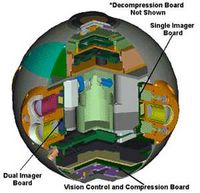Flying Camera Robot Tested at NASA
Work on the volleyball-sized Miniature Autonomous Extravehicular Robotic Camera (Mini AERCam) moved forward with successful initial tests on its docking system. The Mini AERCam is designed to help astronauts and ground crews see outside the spacecraft during a mission. During ground-based testing, the device was able to work with the docking system that serves as an exterior home base for housing and refueling the nanosatellite.

For Shuttle or International Space Station missions, Mini AERCam could support external robotic operations by supplying situational awareness views to operators, supplying views of spacewalk operations to flight and/or ground crews, and carrying out independent visual inspections.
Free-flying spacecraft such as Mini AERCam will be particularly critical for external inspections during long-duration missions, as spacewalks will be kept to a minimum and external camera views may be limited.
The Mini AERCam prototype is just 7.5 inches in diameter and weighs only 10 pounds. The tiny free flyer is designed to be operated by on-orbit flight crews or by ground control personnel. Either could command the nanosatellite to fly automatic maneuvers.

Technology innovations include rechargeable xenon gas propulsion, a rechargeable lithium ion battery, custom avionics based on the PowerPC 740/750 microprocessor, "camera-on-a-chip" imagers with video compression, micro electromechanical system gyroscopes, precise relative GPS navigation, digital radio frequency communications, micro-patch antennas, digital instrumentation networking and compact mechanical packaging.
NASA - NASA Successfully Demonstrates Innovative Nanosatellite System

For Shuttle or International Space Station missions, Mini AERCam could support external robotic operations by supplying situational awareness views to operators, supplying views of spacewalk operations to flight and/or ground crews, and carrying out independent visual inspections.
Free-flying spacecraft such as Mini AERCam will be particularly critical for external inspections during long-duration missions, as spacewalks will be kept to a minimum and external camera views may be limited.
The Mini AERCam prototype is just 7.5 inches in diameter and weighs only 10 pounds. The tiny free flyer is designed to be operated by on-orbit flight crews or by ground control personnel. Either could command the nanosatellite to fly automatic maneuvers.

Technology innovations include rechargeable xenon gas propulsion, a rechargeable lithium ion battery, custom avionics based on the PowerPC 740/750 microprocessor, "camera-on-a-chip" imagers with video compression, micro electromechanical system gyroscopes, precise relative GPS navigation, digital radio frequency communications, micro-patch antennas, digital instrumentation networking and compact mechanical packaging.
NASA - NASA Successfully Demonstrates Innovative Nanosatellite System

0 Comments:
Post a Comment
Subscribe to Post Comments [Atom]
<< Home